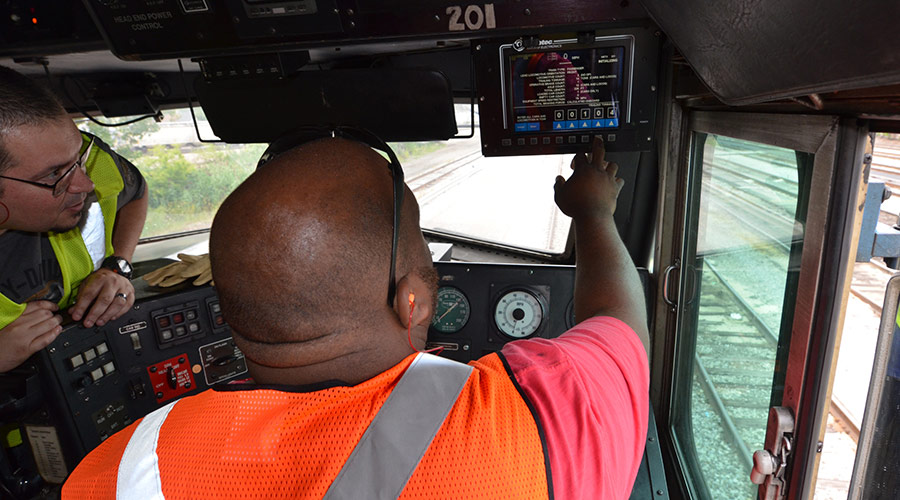Stay updated on news, articles and information for the rail industry
June 2011
Rail News: PTC
C&S: Suppliers prep wayside components to cover the dark territory & trackside monitoring aspects of PTC
By Jeff Stagl, Managing Editor
The regulatory environment surrounding positive train control (PTC) implementation continues to change. In March, the Association of American Railroads and Federal Railroad Administration (FRA) reached an agreement under which the FRA will develop a proposed rulemaking that could scale back some of the requirements stipulated in the final implementation rule.
For example, the new rulemaking might reduce the number of U.S. track miles requiring PTC systems by as many as 10,000 miles and require that a second onboard display unit be non-interactive, or read-only.
Although regulations are subject to change, so are specifications for PTC wayside devices, which monitor control points, switches and signal aspects, and wirelessly interface with onboard locomotive devices and central control systems. An Interoperable Train Control (ITC) Committee, which was created by the four largest U.S. Class Is to develop ITC standards and coordinate interoperability efforts, continues to refine wayside system specifications as wayside technologies are developed and tested.
Ensuring wayside devices work as intended per multiple specification changes — even though some development and testing still hasn’t been completed — is almost as daunting a task as railroads’ mandate to implement PTC by Dec. 31, 2015, wayside system suppliers say.
“Specifications are a challenge. The clock is ticking for railroads, and specifications are changing at the same time,” says Steve Zwart, PTC director for Alstom Signaling Inc., which offers several wayside devices designed for PTC applications.
To roll with the specification changes and meet railroads’ PTC system needs, suppliers are trying to develop more adaptable wayside devices.
They’re offering value-added services, as well. For example, Alstom offers railroads free software upgrades for wayside equipment to keep up with specs.
“If specifications change, the software can be changed at no charge,” says Zwart.
That offer extends to Alstom’s microWIU™, a vital wayside interface unit (WIU) the firm introduced in late 2010. The stand-alone unit is designed for locations without electronics, such as a microprocessor, as an overlay for existing signaling systems. The device can be used to monitor hand-throw switches and other devices in dark territory.
A micro-cosm of PTC
The microWIU is designed to be configured with or without a computer, provide local and remote configuration and monitoring, and meet interoperability requirements, according to Alstom. The unit has a small footprint (3.5 inches wide, 7 inches in height and 11 inches in diameter) to better fit in bungalows and communication equipment boxes, says Zwart. The microWIU is designed to work in conjunction with ACSES II, the latest version of Alstom’s Advanced Civil Speed Enforcement System for PTC.
In February, Amtrak ordered 250 microWIUs, which will be installed on the Northeast Corridor (NEC). The units will play a vital role in Amtrak’s rollout of ACSES II, according to Alstom.
The microWIU chosen by Amtrak evolved from Alstom’s global expertise in PTC systems and solid-state Vital Processor Interlocking technology, according to the supplier. Installations will start on the NEC by year’s end, says Zwart.
Currently, 10 microWIUs are undergoing lab tests by customers; Class Is are testing eight of the units, he says.
Under control
Alstom also offers the 7R Switch Circuit Controller, a recently introduced rail-mounted device that can be coupled with the microWIU. The controller is designed to vitally determine switch status on mainlines, in a yard or dark territory, or as part of PTC or independent detection requirements.
“There are locations where there is a hand-throw switch, and suddenly it has to be recognized as part of a PTC system to ensure safety,” says Zwart.
Earlier this year, CSX Transportation placed an order for the 7R controllers. The device can be quickly clamped to rail or mounted directly to wood ties, eliminating the need for extended ties or track rods for installation, says Zwart.
“Railroads sometimes find that when they need to install a switch in dark territory, there is rotted wood or certain tools are missing,” he says.
In addition, by mounting the controller on rail between ties, the impact of rail-creep on poorly conditioned track beds is minimized, according to Alstom.
The controller is ideal for dark territory applications, but “there are other uses, such as where there’s a need to vitally ensure a good connection between mechanical devices,” says Zwart.
GE Transportation also recently introduced a wayside PTC solution, a complete turnkey system for dark territories. In January, GE teamed up with wireless systems deployment and support firm TESSCO Technologies Inc. to co-produce and market integrated, turnkey PTC and monitoring systems.
The dark territory system features GE’s signaling solutions and expertise, and TESSCO’s communication and radio frequency technology.
The integrated system will address U.S. railroads’ need to implement PTC in more than 7,000 dark territory switch locations, which are not monitored by a signal system, according to GE.
“Together, we bring what we believe is the lowest-cost dark territory solution — a higher-level solution for dark territory,” says Aric Weingartner, GE’s wayside PTC product manager.
Later this year, GE plans to introduce the ElectroBlox™, a stand-alone WIU designed for dark territory locations or signal locations using relays or solid-state equipment that can’t be upgraded for PTC. The ElectroBlox can overlay a relay or solid-state-based signal location, providing signal aspect and switch indications without disarranging existing signal devices, says Weingartner.
Since early 2010, GE has offered four different integrated Plug and Play WIUs designed to upgrade existing GE signal systems and microprocessors.
Getting the message out
Another product set for launch later this year: a wayside message server, which will be take a vital PTC message and communicate it through a railroad’s PTC communication network, says Weingartner. The server will allow for interoperability.
Ansaldo STS is putting the finishing touches on a wayside device, as well. The company is completing environmental testing, including thermal and shock/vibration tests, on the VitalNet™ WIU. The stand-alone unit is designed to transmit wayside information to oncoming locomotives and provide PTC compatibility for dark territory, relays and third-party interlockings.
Environmental testing is slated to conclude in the third quarter, says Greg Allen, Ansaldo’s director of business-PTC and CBTC, adding that field testing is ongoing.
Available as a dark territory or single overlay model, the VitalNet WIU features an embedded web server for configuration and diagnostics, and six or 18 vital inputs. The unit offers flexibility and ease of use because “railroads want something that’s as simple as possible to install and train employees on,” says Allen.
Railroads provided valuable input during the WIU’s development phase, says Portfolio Manager Mike Alexander.
“It wasn’t developed in a vacuum,” he says.
Trying to process it all
Since March 2010, Ansaldo also has offered the MicroLok® II VitalNet™ integrated WIU that features the MicroLok II VitalNet central processing unit and coprocessor to provide complete PTC functionality.
Designed as an overlay, the WIU can be used to replace existing relays, says Alexander. In addition, the device can be used in dark territory as a switch point monitor.
Vossloh/Global Rail Systems is finishing tests on a new WIU, too. By June’s end, the company expects to complete validation testing, including lab and field tests, and begin marketing the EMW1 (Essential Minimum Wayside).
The WIU meets all requirements for interoperability, and offers the smallest footprint and power consumption possible, says Vossloh/Global Rail Systems Vice President of Sales Ron Martin.
“With a smaller device, railroads won’t have to expand their bungalows, and the low power used won’t be a burden on their power systems,” he says.
The EMW1 will be the “brain” of a PTC system, with all modules tied into it, says Martin. The processor-based device will become the company’s universal vital platform, he adds.
Vossloh/Global Rail Systems started from scratch to develop the EMW1, which took about two years to design, says Martin.
“I believe that taking a legacy product and modifying it or enhancing it to work in a PTC environment is a disadvantage,” he says.
Flagship station
At Invensys Rail North America (IRNA), several wayside products designed to help railroads comply with the federal PTC mandate already are available.
The company’s flagship product: the iVIU, a scalable, modular signaling system designed to meet WIU requirements, IRNA officials said in an e-mail.
The iVIU is applicable at relay locations, as an add-on to electronic interlockings, in dark territory switch locations, as a message gateway server and in most other PTC-related designs, they said. The system can be configured as inputs, outputs, lamp drivers, current sensor monitors, battery inputs and relay outputs, all from a single cartridge, according to IRNA.
The iVIU is designed to be expanded from a simple switch monitor or messaging gateway to a complex interlocking controller with built-in WIU functionality.
“By providing a single, scalable system to meet the diverse needs of the customer, training, spare cards, installation, usage and other aspects affecting the total cost of ownership for the product are greatly simplified,” IRNA officials said.
The iVIU’s primary advantages: scalability and functionality, they said.
“The system meets [railroads’] needs through its scalable architecture, vital design, high-quality build process and its advanced user experience, which significantly reduces the learning curve typically associated with new products,” IRNA officials said.
The iVIU currently is undergoing field tests with “targeted Class I partners,” they said.
IRNA modified its GEO product line to allow the addition of the iVIU system as a WIU and/or wayside messaging server. The next release of the GCP4000, IRNA’s flagship crossing control system, will interface to iVIU, enabling next-generation crossing controls to tie into the PTC system, IRNA officials said.
Eye on expertise
Meanwhile, Wabtec Corp. continues to develop I-ETMS, an interoperable iteration of its Electronic Train Management System (ETMS), while at the same time developing and marketing wayside engineering services through its Xorail subsidiary.
I-ETMS has the same functionality as ETMS, but the Interoperable Train Control Committee decided to change the system’s acronym/name to highlight its interoperability, says Jeff Stearns, Wabtec’s VP of train control systems.
In March 2010, Wabtec acquired Xorail L.L.C., a signal engineering and design services firm specializing in wayside signaling and PTC systems.
“We’re using Xorail’s expertise to engineer wayside systems made by others,” says Stearns.
As lab and field testing of wayside devices concludes and PTC system components “come together,” Wabtec’s wayside engineering services “will expand from there,” he says.
Coupled with onboard locomotive devices, back-office servers, management information systems, radio communications and computer-aided dispatching systems, wayside units are part of a complex PTC system that includes “a lot of moving parts,” says Stearns.
The charge for Wabtec and all other PTC equipment suppliers: Keep trying to mold it all into a unified, well-functioning system.
“Everything is a challenge, and everything is coming together,” says Stearns. “We work on it every day.”
E-mail questions or comments to Jeff Stagl, Managing Editor
Keywords
Browse articles on PTC positive train control wayside PTC PTC mandate PTC technology C&SContact Progressive Railroading editorial staff.


 2025 MOW Spending Report: Passenger-rail programs
2025 MOW Spending Report: Passenger-rail programs
 Gardner steps down as Amtrak CEO
Gardner steps down as Amtrak CEO
 Guest comment: Oliver Wyman’s David Hunt
Guest comment: Oliver Wyman’s David Hunt
 Women of Influence in Rail eBook
Women of Influence in Rail eBook
 railPrime
railPrime








